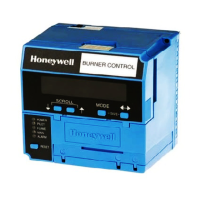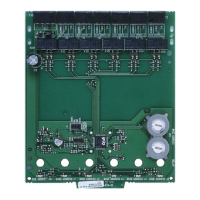RM7898A 7800 SERIES VALVE PROVING PRIMARY RELAY MODULES
32-00209-03 12
*Replace jumper wire with ammeter and verify loads to component ratings.
VALVE PROVING SYSTEM
The Valve Proving System feature provides a systematic way
of testing the valve seat integrity to assure the valves are in
the closed state whenever the sequence of operation
requires them to be closed. It is designed to detect a leak
greater than 0.1% of the burner input capacity. For example,
a 10 million Btu/hr natural gas-fueled burner would have a
fuel input capacity of approximately 1,000 ft
3
/hr. A leak rate
greater than 0.1% of 1,000 ft
3
/hr or 1 ft
3
/hr in either valve
will be detected with the Valve Proving System. Smaller
leaks will not be detected.
At commissioning time, the Valve Proving System may be
scheduled to occur at one of five different times: Never,
Before, After, Both, and Split.
Never—Device default as received: in this case Valve
Proving does not occur.
Before—Valve Proving occurs concurrent with Pre-
Purge.
After—Valve Proving occurs after the Run state before
the internal Safety Relay dropout state and concurrent
with Post Purge (if configured).
Both—Valve Proving occurs at both times Before and
After noted above.
Table 6. Static Checkout.
Test
Numbe
r
Relay
Module
Model
Test
Jumper
s
Voltmete
r Normal Operation
If Operation is Abnormal,
Check Items Listed Below
1 All None 5-L2 Line voltage at terminal 5. 1. Master switch.
2. Power connected to master switch.
3. Overload protection (fuse, circuit
breaker, etc.) has not opened power
line.
2All None6-L2 or
17-L2
Line voltage at terminal 6 or 17.
For Valve Proving.
1. Limits.
2. Burner controller.
3 All 4-5 7-L2 1. Burner motor (fan or blower)
starts.
2. Line voltage at terminal 7
within 10 seconds.
1. Burner motor circuit.
a. Manual switch of burner motor.
b. Burner motor power supply,
overload
protection and starter.
c. Burner motor.
4 All 20-L2 Line voltage at Terminal 20 Pre-Ignition Interlocks.
5 All 5-10* — 1. Ignition spark (if ignition
transformer is connected to
terminal 10).
1. Watch for spark or listen for buzz.
a. Ignition electrodes are clean.
b. Ignition transformer is okay.
6All 5-8*— 1. Ignition spark (if ignition
transformer is connected
to terminal 8).
2. Automatic pilot valve
opens
(if connected to terminal
8).
NOTE: Refer to wiring diagram
of system being tested.
1. Watch for spark or listen for buzz.
2. Listen for click or feel head of valve for
activation.
a. Actuator if used.
b. Pilot valve.
7All 5-9*— Automatic fuel valve(s) open(s).
If using direct spark ignition,
check first stage fuel valve(s)
instead of pilot valve.
Same as test 6. If using direct spark
ignition, check first stage fuel valve(s)
instead of pilot valve.
8 All 5-21* — Automatic second stage main
fuel valve(s) open(s).
1. Listen for and observe operation of
second stage main fuel valve(s) and
actuator(s).
2. Valve(s) and actuator(s).
9 All 5-3 — Alarm (if used) turns on. 1. Alarm.
Final All
Equipment Damage Hazard.
Can cause equipment damage.
After completing these tests, open master switch and remove all test jumpers from
subbase terminals. Also remove bypass jumpers, if used, from low fuel pressure limits.

